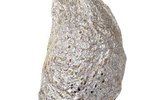
Blue morpho butterflies live mostly in Central and South America, ranging from southern Mexico to Colombia. They prefer the protection of the rainforest, which offers them shelter and a place to hide from predators. One of the largest butterflies, blue morphos exhibit wingspans of up to 8 inches. Such a large butterfly could make a tasty treat for birds and other predators, but blue morphos have a secret weapon that works in conjunction with their shelter: camouflaging wings.
When Life Begins
When the caterpillar of a blue morpho butterfly hatches, he's already designed to blend in with his environment. The caterpillar is brown with hints of red and green areas near his hind end. This helps him hide among the leaves near the forest floor. His prickly hairs sting potential predators, helping to discourage them from eating him until he matures enough to pupate. The green chrysalis the caterpillar creates is hard for predators to spot among the tree and shrub leaves of the rainforest.
Sticking to the Bottom
After emerging the chrysalis as an adult, a blue morpho butterfly has one mission: survive long enough to mate. To accomplish this, he sticks to what he considers safe shelter near the forest floor. Most predators, usually birds or large insects, seek prey higher in the canopy, so the blue morpho prefers the security found at lower elevations. With plentiful food near and on the forest floor, shrubs and lower tree branches provide excellent protection for the butterflies.
A Tale of Two Wings
The type of shelter a blue morpho seeks relates directly to his main form of camouflage: his wings. The top side sports a brilliant blue, which is easily seen by predators as well as potential mates. The bottom side, however, is completely different -- it's covered with dull brown and black colors, forming eye spots that help break up the butterfly's lines. When his wings are closed, the dull colors blend in nicely with a background of small branches on the trees and shrubs where the butterflies find shelter.
Hiding in Flight
The two-toned wings help hide the butterfly even when he's in flight above his preferred shelter area. A predator might easily spot the blue on the top of the butterfly's wings, but as he flaps, the predator can lose him in the background of the foliage as the butterfly shows the dull bottom of his wings. Called flashing, this confuses predators as they see only flashes of the prey -- they have trouble following a blue morpho because he seems to disappear and reappear.
References
Photo Credits
-
Brand X Pictures/Stockbyte/Getty Images


